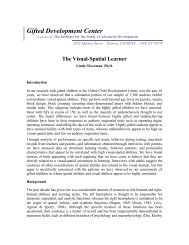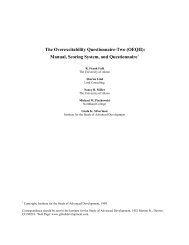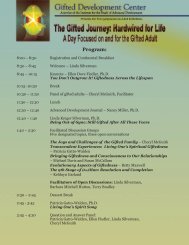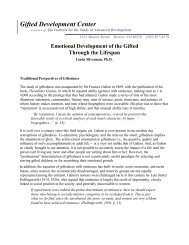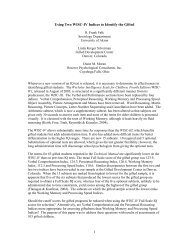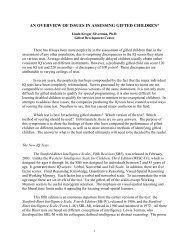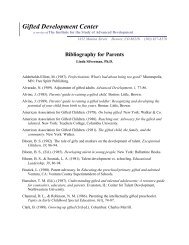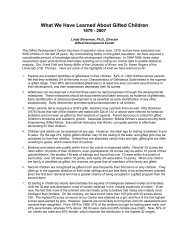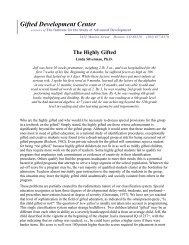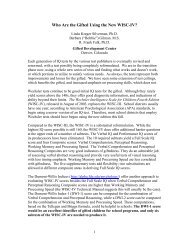THE CONUNDRUMS OF SUCCESS - the Gifted Development Center
THE CONUNDRUMS OF SUCCESS - the Gifted Development Center
THE CONUNDRUMS OF SUCCESS - the Gifted Development Center
You also want an ePaper? Increase the reach of your titles
YUMPU automatically turns print PDFs into web optimized ePapers that Google loves.
(Grant & Piechowski, 1999, p.8, cited Silverman, in press, p. 23). As you consider this,you may perhaps be reminded of <strong>the</strong> high school I described earlier: it seems a fairlyaccurate comparison.In contrast, Silverman pleads for us to recognise that a focus on <strong>the</strong> gifted child’sexperience in childhood matters, “not merely in terms of how it shapes or foreshadows<strong>the</strong>ir adult lives, but because childhood is precious in and of itself, and children’shappiness or misery is important.” (Silverman, in press, p.24).Grant and Piechowski assert that in fact child-centredness is <strong>the</strong> “moral responsibility ofgifted educators”, stating that:To recognise also means to acknowledge, to accept what we have identified in itsown right and on its own terms …. Being child-centred means respectingchildren’s autonomy, providing experiences that enable children to follow <strong>the</strong>irpassions and be self-actualising, and seeking to understand things from a child’spoint of view. The strongest argument for child-centredness is that it regardschildren as ends, not means…. It does not impose a way of being on <strong>the</strong>m.(Grant & Piechowski, 1999, pp. 6-8, cited Silverman, in press, p.24).What does this mean in practice for children’s lives? If one picture is worth a thousandwords, <strong>the</strong>n perhaps sometimes one quote is worth a thousand academic papers. I’mthinking of a line from a poem by a nine-year-old boy which a colleague recently sentme:Like chalk, I crush easily.What do those few stark words tell us about that child’s experience of school?Many of you who are here as parents will hear that child’s cry echoing in your hearts asyou think of your own child. Dabrowski’s work on “over-excitabilities” has simplyconfirmed what we as parents already know, that gifted children have profoundlyheightened sensitivities, and experience life with an intensity that is beyond <strong>the</strong>comprehension of most. That is something that brings with it <strong>the</strong> capacity for both greatjoys and great griefs. It is a capacity which at one and <strong>the</strong> same time makes <strong>the</strong> giftedchild uniquely vulnerable and yet which also plays an integral part in shaping thoseinsights and perceptions that are <strong>the</strong> most valued creations of <strong>the</strong> gifted mind and <strong>the</strong>gifted imagination.The third conundrum: where to from here?I should think that by now it is fairly obvious on which <strong>the</strong> side of <strong>the</strong> fence you will findme. Throughout all my years in education, I have believed in and sought to follow achild-centred approach, an approach which holds that <strong>the</strong> nurturing of a child’simaginational, emotional, social and ethical growth is as integral to <strong>the</strong> child’s11



